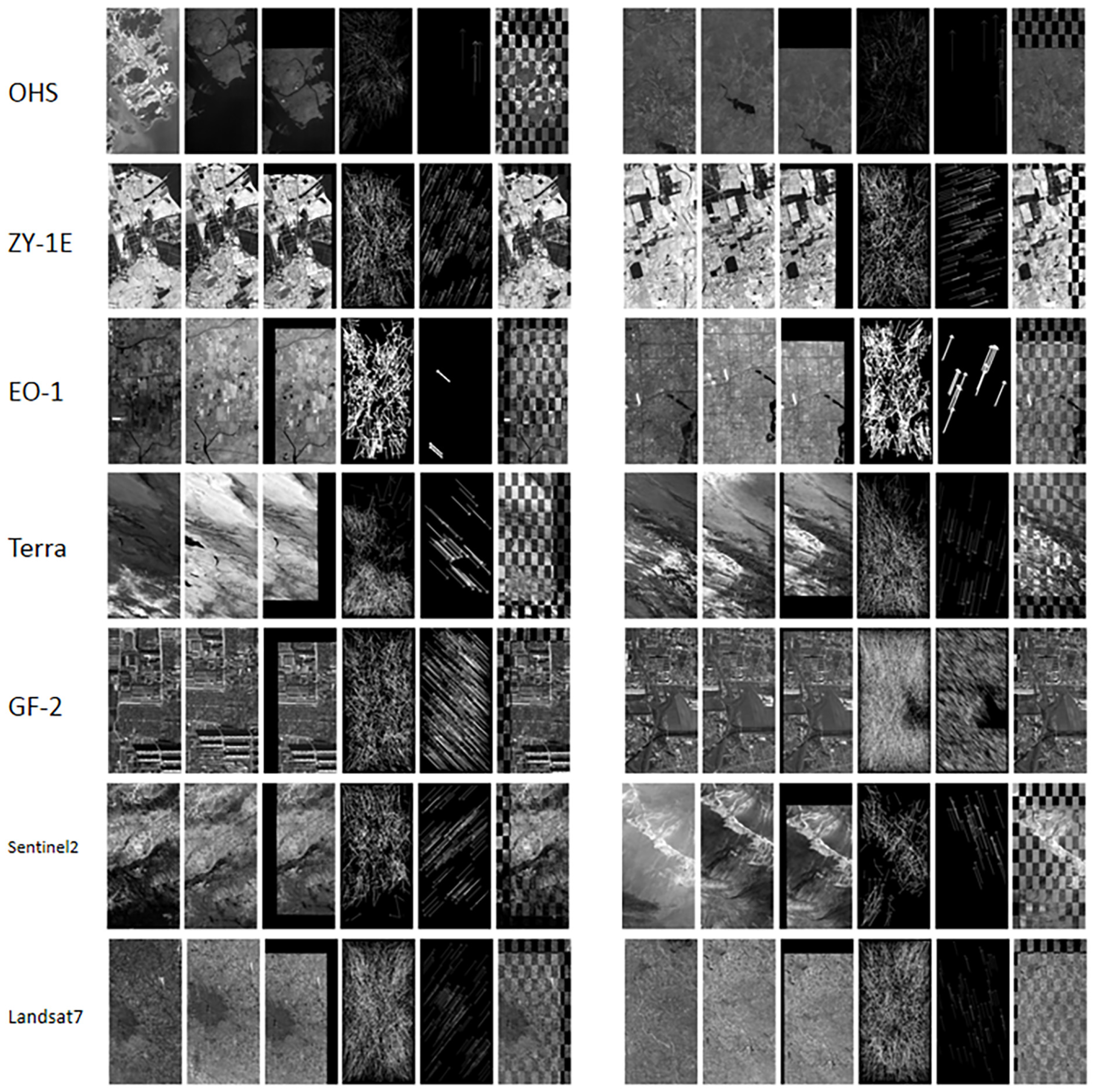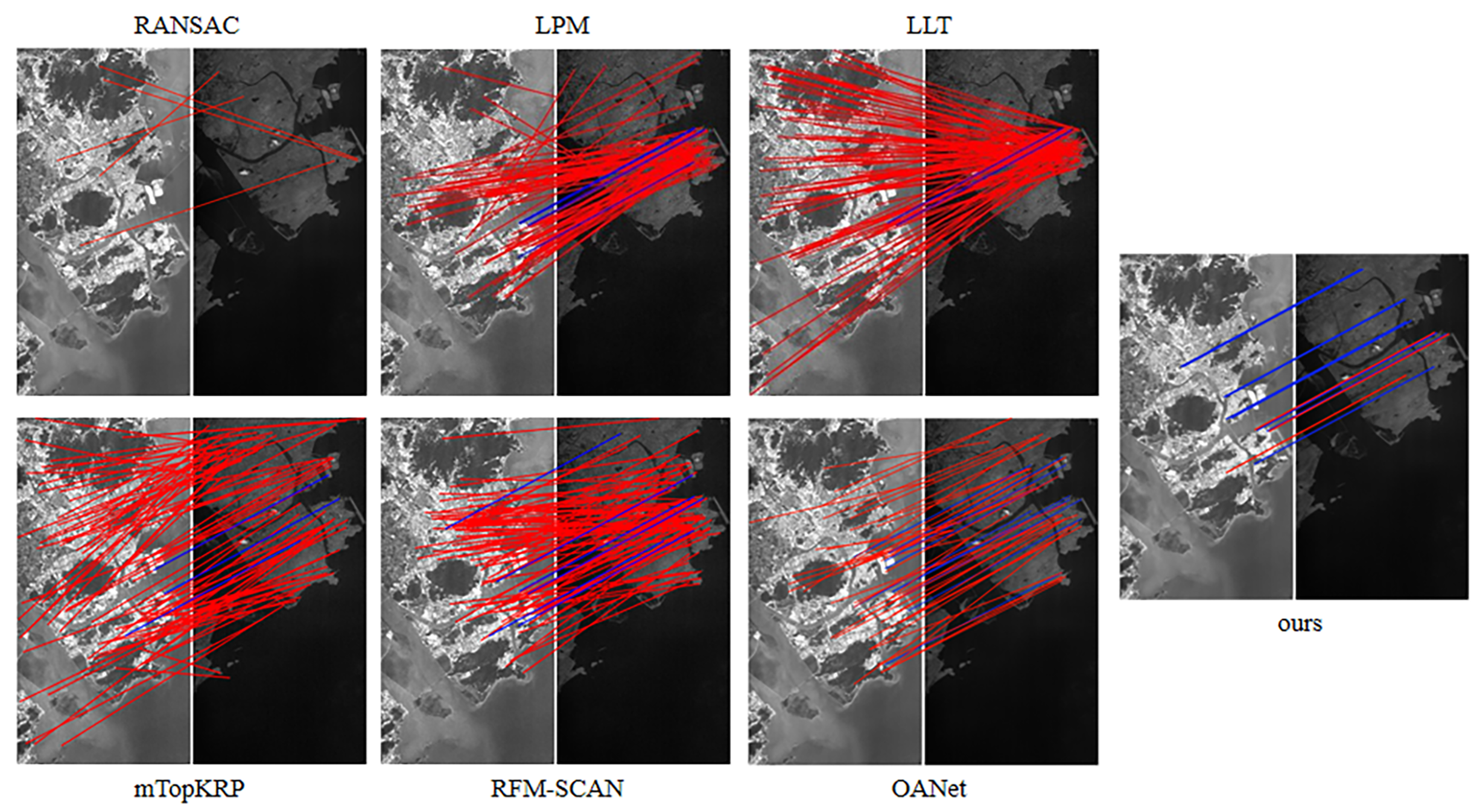An Interband Registration Method for Hyperspectral Images Based on Adaptive Iterative Clustering
Abstract
1. Introduction
2. Related Works
3. Method
3.1. Problem Formulation
| Algorithm 1: Feature matching based on iterative clustering |
| Input: Inferred matching set: S, initial value of k: k, the maximum number of iterations: max |
| Output: Output: inlier set: I |
| 1: Calculate using Equation (1) |
| 2: Calculate using Equation (2) |
| 3: Calculate using Equation (3) |
| 4: Combine , and into a four-dimensional descriptor |
| 5: Use principal component analysis to reduce the four dimensions to three dimensions |
| 6: Iteration: |
| 7: Start k-means using the initial value or the k value obtained from the last iteration |
| 8: Count the number of points in each cluster and calculate in the clustering result |
| 9: Calculate the value of k in the next iteration using Equation (11) |
| 10: The cluster with the largest number of points forms the point set I |
| 11: Until decreases for the first time or the number of iterations>max |
| 12: Return I |
3.2. Establishment of the Four-Dimensional Descriptor
3.3. Iterative Clustering
3.4. Registration and Time Complexity Analysis
3.5. Implementation Details
4. Experimental Results
4.1. Multi-Scene Interband Registration of Hyperspectral Images
4.2. Interband Registration Experiment between Multiple Remote Sensing Image
4.3. Comparison of Different Algorithms
4.3.1. Feature Matching
4.3.2. Interband Registration
4.4. Supplementary Experiment
4.5. Discussion
5. Conclusions
Author Contributions
Funding
Institutional Review Board Statement
Informed Consent Statement
Data Availability Statement
Acknowledgments
Conflicts of Interest
References
- Ma, Y. Fusion of high spatial resolution and high spectral resolution remote sensing images. Infrared 2003, 000(010), 11–16. [Google Scholar]
- Lowe, D. Distinctive Image Features from Scale-Invariant Keypoints. Int. J. Comput. Vis. 2004, 20, 91–110. [Google Scholar] [CrossRef]
- Bay, H.; Ess, A.; Tuytelaars, T.; Gool, L.V. Speeded-Up Robust Features (SURF). Comput. Vis. Image Underst. 2008, 110, 346–359. [Google Scholar] [CrossRef]
- Rublee, E.; Rabaud, V.; Konolige, K.; Bradski, G. ORB: An efficient alternative to SIFT or SURF. In Proceedings of the 2011 International Conference on Computer Vision, Barcelona, Spain, 6–13 November 2011. [Google Scholar]
- Dalal, N.; Triggs, B. Histograms of Oriented Gradients for Human Detection. In Proceedings of the 2005 IEEE Computer Society Conference on Computer Vision and Pattern Recognition (CVPR’05), San Diego, CA, USA, 20–25 June 2005. [Google Scholar]
- Ye, Y.; Bruzzone, L.; Shan, J.; Bovolo, F.; Zhu, Q. Fast and Robust Matching for Multimodal Remote Sensing Image Registration. IEEE Trans. Geoence Remote Sens. 2019, 57, 9059–9070. [Google Scholar] [CrossRef]
- Ye, Y.; Shen, L. Hopc: A novel similarity metric based on geometric structural properties for multi-modal remote sensing image matching. ISPRS Ann. Photogramm. Remote Sens. Spat. Inf. 2016, 3, 9. [Google Scholar] [CrossRef]
- Fischler, M.A. Random sample consensus: A paradigm for model fitting with applications to image analysis and automated cartography. Read. Comput. Vis. 1987, 726–740. [Google Scholar] [CrossRef]
- Torr, P.; Zisserman, A. MLESAC: A New Robust Estimator with Application to Estimating Image Geometry. Comput. Vis. Image Underst. 2000, 78, 138–156. [Google Scholar] [CrossRef]
- Ni, K.; Jin, H.; Dellaert, F. GroupSAC: Efficient consensus in the presence of groupings. In Proceedings of the 2009 IEEE 12th International Conference on Computer Vision, Kyoto, Japan, 29 September–2 October 2009. [Google Scholar]
- Chum, O.; Matas, J.; Kittler, J. Locally Optimized RANSAC. In Lecture Notes in Computer Science; Springer: Berlin/Heidelberg, Germany, 2003. [Google Scholar]
- Lebeda, K.; Matas, J.; Chum, O. Fixing Locally Optimized RANSAC—Full Experimental Evaluation. In Proceedings of the British Machine Vision Conference, Surrey, UK, 3–7 September 2012. [Google Scholar]
- Chum, O.; Matas, J. Optimal randomized RANSAC. IEEE Trans. Pattern Anal. Mach. Intell. 2008, 30, 1472–1482. [Google Scholar] [CrossRef]
- Parra Bustos, A.; Chin, T.J. Guaranteed Outlier Removal for Point Cloud Registration with Correspondences. IEEE Trans. Pattern Anal. Mach. Intell. 2017, 40, 2868–2882. [Google Scholar] [CrossRef]
- Jiang, X.; Ma, J.; Fan, A.; Xu, H.; Tian, X. Robust Feature Matching for Remote Sensing Image Registration via Linear Adaptive Filtering. IEEE Trans. Geoence Remote Sens. 2020, 1–15. [Google Scholar] [CrossRef]
- Ma, J.; Zhao, J.; Guo, H.; Jiang, J.; Gao, X. Locality Preserving Matching. Int. J. Comput. Vis. 2019, 127, 512–531. [Google Scholar] [CrossRef]
- Jiang, X.; Jiang, J.; Fan, A.; Wang, Z.; Ma, J. Multiscale Locality and Rank Preservation for Robust Feature Matching of Remote Sensing Images. IEEE Trans. Geoence Remote Sens. 2019, 57, 6462–6472. [Google Scholar] [CrossRef]
- Ma, J.; Zhou, H.; Zhao, J.; Gao, Y.; Jiang, J.; Tian, J. Robust Feature Matching for Remote Sensing Image Registration via Locally Linear Transforming. IEEE Trans. Geoence Remote Sens. 2015, 53, 6469–6481. [Google Scholar] [CrossRef]
- Ma, J.; Jiang, X.; Jiang, J.; Guo, X. Robust Feature Matching Using Spatial Clustering With Heavy Outliers. IEEE Trans. Image Process. 2019, 29, 736–746. [Google Scholar]
- Ester, M.; Kriegel, H.P.; Sander, J.; Xu, X. A Density-Based Algorithm for Discovering Clusters in Large Spatial Databases with Noise. Kdd 1996, 96, 226–231. [Google Scholar]
- Yi, K.; Trulls, E.; Ono, Y.; Lepetit, V.; Salzmann, M.; Fua, P. Learning to Find Good Correspondences. In Proceedings of the IEEE Conference on Computer Vision and Pattern Recognition (CVPR), Salt Lake City, UT, USA, 18–22 June 2018. [Google Scholar]
- Zhao, C.; Cao, Z.; Li, C.; Li, X.; Yang, J. NM-Net: Mining Reliable Neighbors for Robust Feature Correspondences. In Proceedings of the IEEE/CVF Conference on Computer Vision and Pattern Recognition (CVPR), Long Beach, CA, USA, 16–20 June 2019. [Google Scholar]
- Wang, S.; Quan, D.; Liang, X.; Ning, M.; Guo, Y.; Jiao, L. A deep learning framework for remote sensing image registration. ISPRS J. Photogramm. Remote Sens. 2018, 145, 148–164. [Google Scholar] [CrossRef]
- Zhang, J.; Sun, D.; Luo, Z.; Yao, A.; Zhou, L.; Shen, T.; Chen, Y.; Liao, H.; Quan, L. Learning Two-View Correspondences and Geometry Using Order-Aware Network. In Proceedings of the IEEE/CVF International Conference on Computer Vision (ICCV), Seoul, Korea, 27 October–2 November 2019. [Google Scholar]
- Marin, M.; Moonen, L.; Deursen, A.V. Seventh IEEE International Working Conference on Source Code Analysis and Manipulation-Title. In Proceedings of the IEEE Seventh IEEE International Working Conference on Source Code Analysis and Manipulation (SCAM 2007), Paris, France, 30 September–1 October 2007; pp. 101–110. [Google Scholar]
- Bellman, R. Dynamic Programming. Science 1966, 153, 34–37. [Google Scholar] [CrossRef] [PubMed]
- Hinneburg, A.; Aggarwal, C.C.; Keim, D.A. What Is the Nearest Neighbor in High Dimensional Spaces? In Proceedings of the 26th Internat. Conference on Very Large Databases, Cairo, Egypt, 10–14 September 2000. [Google Scholar]
- MacQueen, J. Some methods for classification and analysis of multivariate observations. Berkeley Symp. Math. Stat. Probab. 1967, 5.1, 281–297. [Google Scholar]
- Huang, Z. Extensions to the k-Means Algorithm for Clustering Large Data Sets with Categorical Values. Data Min. Knowl. Discov. 1998, 2, 283–304. [Google Scholar] [CrossRef]
- George Karypis, E.A. CHAMELEON: A Hierarchical Clustering Algorithm Using Dynamic Modeling. Computer 2008, 32, 68–75. [Google Scholar] [CrossRef]
- Dempster, A.P. Maximum likelihood from incomplete data via the EM algorithm. J. R. Stat. Soc. 1977, 39, 1–22. [Google Scholar]
- Kohone, T. Self Organizing Feature Maps; Springer: Berlin/Heidelberg, Germany, 1988. [Google Scholar]
- Peter, R.J. Silhouettes: A graphical aid to the interpretation and validation of cluster analysis. J. Comput. Appl. Math. 1999, 20, 53–65. [Google Scholar]
- Calinski, T.; Harabasz, J. A dendrite method for cluster analysis. Commun. Stat. 1974, 3, 1–27. [Google Scholar]
- Bookstein, F.L. Principal warps: Thin-plate splines and the decomposition of deformations. IEEE Trans. Pattern Anal. Mach. Intell. 2002, 6, 567–585. [Google Scholar] [CrossRef]
- Li, Q.; Zhong, R.; Wang, Y. A Method for the Destriping of an Orbita Hyperspectral Image with Adaptive Moment Matching and Unidirectional Total Variation. Remote. Sens. 2019, 11, 2098. [Google Scholar] [CrossRef]











| Number | Satellite | Band | Size | Resolution | Main Feature |
|---|---|---|---|---|---|
| 1 | OHS | B15 + B32 | 2000 × 4000 | 10 m | city, forest |
| 2 | OHS | B15 + B32 | 2000 × 4000 | 10 m | farmland |
| 3 | ZY-1E | SW10 + SW60 | 480 × 992 | 30 m | coastal, city |
| 4 | ZY-1E | SW10 + SW61 | 500 × 1000 | 30 m | farmland |
| 5 | EO-1 | B20 + B52 | 150 × 300 | 30 m | lake |
| 6 | EO-1 | B20 + B53 | 150 × 300 | 30 m | river |
| 7 | Terra | B01 + B06 | 800 × 1600 | 250 m/500 m | mountain |
| 8 | Terra | B01 + B06 | 800 × 1600 | 250 m/500 m | mountain |
| 9 | GF-2 | B01 + B02 | 480 × 992 | 4 m | city, building |
| 10 | GF-2 | B01 + B03 | 2000 × 4000 | 4 m | city, road |
| 11 | Sentinel-2 | B01 + B09 | 500 × 1000 | 60 m | plain |
| 12 | Sentinel-2 | B01 + B09 | 500 × 1000 | 60 m | mountain |
| 13 | Landsat7 | B01 + B07 | 1000 × 2000 | 30 m | city, plain |
| 14 | Landsat7 | B02 + B07 | 1000 × 2000 | 30 m | city, plain |
| Method | Time (Second) | Feature Point Num | Correct Num | Precision | Recall | F-Score |
|---|---|---|---|---|---|---|
| RANSAC | 0.646 | 5 | 0 | 0% | 0% | 0 |
| LPM | 0.1935 | 82 | 5 | 6.10% | 41.7% | 0.106 |
| LLT | 0.0264 | 275 | 5 | 1.10% | 1.8% | 0.417 |
| mTopKRP | 0.6365 | 269 | 12 | 4.46% | 100% | 0.0854 |
| RFM-SCAN | 0.8706 | 173 | 12 | 6.94% | 100% | 0.1297 |
| OANet | 6.082 | 89 | 12 | 13.48% | 100% | 0.2375 |
| ours | 0.731 | 15 | 12 | 80% | 100% | 0.889 |
| Method | RMSE | MAE | MEE |
|---|---|---|---|
| RANSAC | 2447.0225 | 2945.2039 | 2399.8601 |
| LPM | 1396.2812 | 2645.1846 | 1187.8166 |
| LLT | 608.6681 | 1554.3046 | 457.6702 |
| mTopKRP | 1555.5864 | 2975.7701 | 1545.7018 |
| RFM-SCAN | 1175.3445 | 2252.4515 | 1126.6998 |
| OANet | 1723.7394 | 2492.9500 | 1676.8652 |
| ours | 0.6352 | 0.8354 | 0.7291 |
Publisher’s Note: MDPI stays neutral with regard to jurisdictional claims in published maps and institutional affiliations. |
© 2021 by the authors. Licensee MDPI, Basel, Switzerland. This article is an open access article distributed under the terms and conditions of the Creative Commons Attribution (CC BY) license (https://creativecommons.org/licenses/by/4.0/).
Share and Cite
Wu, S.; Zhong, R.; Li, Q.; Qiao, K.; Zhu, Q. An Interband Registration Method for Hyperspectral Images Based on Adaptive Iterative Clustering. Remote Sens. 2021, 13, 1491. https://doi.org/10.3390/rs13081491
Wu S, Zhong R, Li Q, Qiao K, Zhu Q. An Interband Registration Method for Hyperspectral Images Based on Adaptive Iterative Clustering. Remote Sensing. 2021; 13(8):1491. https://doi.org/10.3390/rs13081491
Chicago/Turabian StyleWu, Shiyong, Ruofei Zhong, Qingyang Li, Ke Qiao, and Qing Zhu. 2021. "An Interband Registration Method for Hyperspectral Images Based on Adaptive Iterative Clustering" Remote Sensing 13, no. 8: 1491. https://doi.org/10.3390/rs13081491
APA StyleWu, S., Zhong, R., Li, Q., Qiao, K., & Zhu, Q. (2021). An Interband Registration Method for Hyperspectral Images Based on Adaptive Iterative Clustering. Remote Sensing, 13(8), 1491. https://doi.org/10.3390/rs13081491







